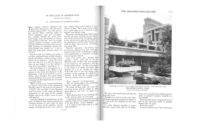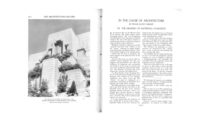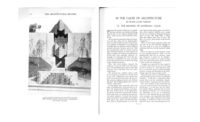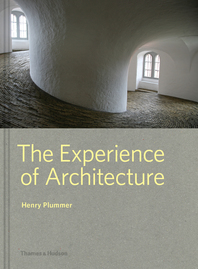From Architectural Record, May, 1928. Read a PDF of the original article here.
From the fantastic totem of the Alaskan – erected for its own sake as a great sculptured pole, seen in its primitive colors far above the snows – to the resilient bow of the American Indian, and from the enormous solid polished tree-trunks upholding the famous great temple-roofs of Japan to the delicate spreading veneers of rare, exotic woods on the surfaces of continental furniture, wood is allowed to be wood.
It is the most humanly intimate of all materials. Man loves his association with it, likes to feel it under his hand, sympathetic to his touch and to his eye. Wood is universally beautiful to Man. And yet, among higher civilizations, the Japanese understood it best.
They have never outraged wood in there are or in their craft. Japan’s primitive religion, “Shinto,” with its “be clean” ideal, found in wood ideal material and gave it ideal use in that masterpiece of architecture, the Japanese dwelling as well as in all, that pertained to living in it.
In that architecture may be seen what a sensitive material, let along for its own sake, can do for human sensibilities.
Whether pole, beam, plank, board, slat or rod, the Japanese architect got the forms and treatments of his architecture out of tree-nature, wood-wise, and heightened the natural beauty of the material by cunning peculiar to himself.
The possibilities of the properties of wood came out richly as he rubbed into it the natural oil of the palm of his hand, ground out the soft parts of the grain to leave the hard fibre standing – an “erosion” like that of a plain where flowing water washes away the sand from the ribs of stone.
Now western peoples ever used wood with such understanding as the Japanese did in their construction – where wood always came up and came out as nobly beautiful.
And when we see the bamboo rod in their hands – seeing a whole industrial world interpreting it into articles of use and art that ask only to be bamboo – we reverence the scientific art that makes wood theirs.
The simple Japanese dwelling with its fences and utensils is the revelation of wood.
Nowhere else may wood be so profitably studied for its natural possibilities as a major architectural material.
Material here feel into artistic hands – a religious sentiment protecting it, in all reverence for simplicity.
Sometimes in the oak-beamed and paneled rooms of Old England, when “carpentry” was restrained, oak was allowed to be something similar as is seen in oak-timbering of the Middle Ages. In the veneering of later periods the beauty of wood came out – but the carpenter-forms of the work invariably did violence to the nature of wood. The “cabinet-maker” had his way with it.
Woodwork soon became what we learned to call carpentry; more or less a make-shift. Paneling was its sum and substance where the pilaster would not stick nor the cornice hand.
All wooden joinery of the periods, soon or late, fell to pieces, and the interruption by too many ingenious “members” frittered away wood-nature in confusion or in contortions of an ingenious but false or inferior “taste.”
Outside primitive architectures, sympathetic use of wood in beautiful construction would be found far north or far south – among the Norsemen, or among the South Sea Islanders.
Because of wood we have – the carpenter.
The carpenter loved wood in feeble ways – but he loved his tools with strength and determination. He loved his tools more. Good wood is willing to do what its designer never meant it to do – another of its lovable qualities – but therefore it is soon prostitute to human ingenuity in the makeshift of the carpenter. Wood, therefore, has more human outrage done upon it than man has done, even upon himself.
It has suffered more – fare more than any of the materials in our category.
Where and when it is cheap and, so, become too familiar as it nearly always does in a new country, it soon falls into contempt. Man’s longing for novelty tries to make it something else. To the degree that the carpenter-artist has succeeded in doing this – one might thing – is he the artist-carpenter.
In his search for novelty, wood in his hands has bene joined and glued, braced and screwed, boxed and nailed, turned and tortured, scroll sawed, beaded, fluted, suitably furbelowed and flounced at the carpenter’s party – enough to please even him. By the aid of “modern” machines the carpenter-artist got it into Eastlake composites of trim and furniture, into Usonian jigger porches and corner-towers eventuating into candle snuffer domes or what would you have?; got it all over Queen Anne houses outside and inside – the triumph of his industrious ingenuity – until carpentry and millwork become synonymous with butchery and botchwork.
Queen Anne! What murder!
And even now – especially now – in the passing procession of the “periods” I never see orderly piles of freshly cut and tried timber disappearing into the mills to be gored and ground and torn and hacked into millwork without a sense of utter weariness in the face of the overwhelming outrage of something precious just because it I by nature so kind, beneficent and lovely.
Man has glorified the Tree in the use he made of the Stick – but that he did long before the Louis, or the Renaissance got by way of Colonial and Eastlake – or was it Westlake – to Queen Anne; and then by way of the triumphant Machine to General-Grant-Gothic and the depths of degradation that soon came in the cut-and-butt of the fluted “trim,” with turned corner-block and molded plinth-block.
This latter was the fashion in woodwork when I found the uses of wood I shall describe.
Machinery in that era was well under way and ploughed and tore and whirled and gouged in the name of Art and Architecture.
And all this was so effectually and busily done that the devastation began to be felt in the “boundless” Usonian forests. Conservative lumber-men took alarm and made the native supply go a little further by shrinking all the standard timber-sizes first, one-eighth of an inch both ways – then a little further on one-eighth inch more both ways – now still a little further – until a stud is become a bed-slat, a board kin to a curling veneer.
All standardized sticks great and small are shrinking by a changing standard to meet the deadly facility which the Machine has given to man’s appetite for useless things.
Usonian forests show all too plainly terrible destruction and – bitter thought – nothing of genuine beauty as Usonia to show for it.
The darkness of death is descending on wood by way of unenlightened architecture.
The life of the tree has bene taken in vain as the stick, the substance of the shapely stick to become imitation-a-la-mod; the precious efflorescent patterns of wood, to be painted out of sight; its silken textures vulgarized by varnish in the misshapen monstrosities of a monstrous “taste.”
The noble forest is become ignominious scrap-heap in the name of Culture.
The Machine, then – was it – that placed this curse on so beautiful a gift to man? So friendly a material – this brother to the man – laid thus low in murder.
No.
Unless the sword in the hand of the swordsman murdered the man whose heart it ran through.
The Machine in only a tool. Before all, the man is responsible for its use.
His ignorance became devastation because his tool in callous hands became a weapon effective beyond any efficiently such hands had ever known before, or any sensibilities he ever had. His performance with his Machine outran not only his imagination which, long since, it vanquished, but the endurance of his own sensibilities as human.
No. Blame the base appetite the Machine released upon the forest, for its devastation. Blame the lack of imaginative insight for the scrap-heap we have now to show for the lost trees of a continent – a scrap-heap instead of a noble architecture.
What should we have had to show were it otherwise? Vain speculation. What may we have to show for what is left – if base appetite becomes enlightened desire and imagination awakes and sees?







